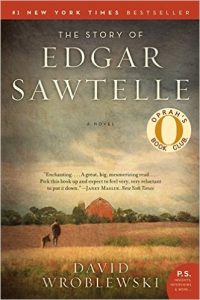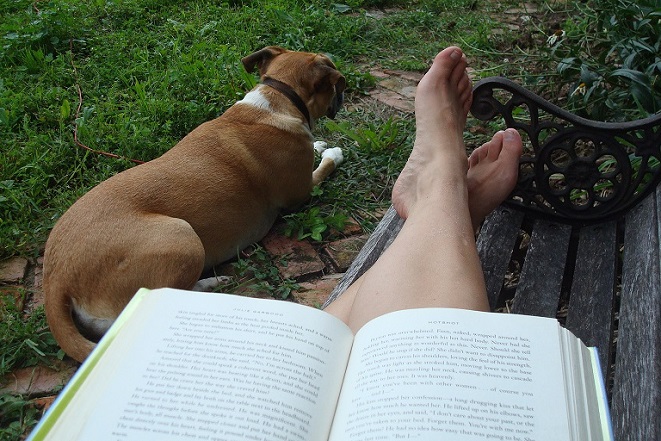Note: Julia Thomson is a regular contributor to That Mutt. Read more of her posts here.
 “Unless they had worked long and hard at it, most people thought training meant forcing their will on a dog. Or that training required some magical gift. Both ideas were wrong. Real training meant watching, listening, diverting a dog’s exuberance, not suppressing it.”
“Unless they had worked long and hard at it, most people thought training meant forcing their will on a dog. Or that training required some magical gift. Both ideas were wrong. Real training meant watching, listening, diverting a dog’s exuberance, not suppressing it.”
– The Story of Edgar Sawtelle by David Wroblewski
The Story of Edgar Sawtelle is fiction. However, as I was reading it I knew I wanted to write about it here, on this very non-fiction blog.
The book is about a lot of things—family, language, communication, loss, love. (More info on Amazon here.)
However, dogs are at the core of the story. And some of the concepts discussed—the quest for the “best” dog and living with dogs—are a perfect fit for That Mutt.
First, a bit of background on the story.
Edgar Sawtelle’s grandfather, John, loves dogs. He was also “born with an extra share of whimsy.” At one point in John’s life he comes across some Very Good Dogs. The idea comes to him to breed these dogs to see if he can create a Very Very Good Dog. And so begins this fictional breed of dogs, the Sawtelles.
[quote_center]The discussion of breeds and integrity and the “best” dog were very interesting in the book.[/quote_center]
The discussion of breeds and integrity and the “best” dog were very interesting in the book.
So much of dog breeding in real life is focused on purity and consistency. One very good example of a German Shepherd crossed with another very good example of a German Shepherd. Special consideration given to heredity, health, temperament, behaviour and other issues. The goal being “the perfection of a breed.”

John Sawtelle’s approach is to pick outstanding examples of dogs—all dogs, not one particular breed—and cross them into his line. In the book, Edgar finds newspaper clippings about dogs that had saved people from drowning and letters that his grandfather wrote to inquire about these amazing dogs.
John’s goal is to breed dogs who are the best companions. There are descriptions throughout the book of how closely the Sawtelle dogs watch their owners and are attuned to their owners.
Which brings us to training.
The Sawtelles keep their dogs until they are 18 months old. Over that whole time, they have a training regime that they follow to prepare the dogs to be the best companions.
From The Story of Edgar Sawtelle:
 “For the blind and deaf neonates there were touch and scent regimes to be followed… For the newly open-eyed, there was a schedule of experiences, from the jingling of car keys to the appearance of an old bicycle horn… A patch of carpet to walk on. A tube. A block. Sandpaper. Ice… Sessions with aunts and uncles, learning manners… The infants needed to learn the simplest things: to look, to listen, to watch, to wait… The adolescents—those robbers, thieves, muggers and bullies, who knew exactly what you wanted and devoted themselves to the opposite—needed every spare minute and more.”
“For the blind and deaf neonates there were touch and scent regimes to be followed… For the newly open-eyed, there was a schedule of experiences, from the jingling of car keys to the appearance of an old bicycle horn… A patch of carpet to walk on. A tube. A block. Sandpaper. Ice… Sessions with aunts and uncles, learning manners… The infants needed to learn the simplest things: to look, to listen, to watch, to wait… The adolescents—those robbers, thieves, muggers and bullies, who knew exactly what you wanted and devoted themselves to the opposite—needed every spare minute and more.”
And so on and so on until the dogs have mastered complex behaviours, can handle diverse situations, know what’s expected of them and are ready to go to their new homes equipped to be the best companions they can be.
Throughout, the philosophy of training is one of respecting the dogs and finding the ways together to achieve the desired behaviour.
The Story of Edgar Sawtelle, though fiction, is an interesting investigation into breeding, training, behaviour and the incredible bonds between dogs and humans. It made me reflect on my own approaches with my dog Baxter and the relationship that we’ve built.
Do you think it’s possible to breed the “best” dog?
Do you have any dog books on your summer reading list?
If you’re interested in The Story of Edgar Sawtelle, it’s available on Amazon.
This post contains affiliate links.

Keith Amdur
Thursday 1st of December 2016
I get a lot of books from Amazon and DogWise.Got a kindle and Amazon Prime reading.The Culture Clash by Jean Donaldson is a good book to read.How to speak Dog and How Dogs Think by Stanley Coren,Inside of a Dog and Being a Dog by Alexandra Horowitz.She has another book "On Looking", about how to look at the world around you when your out on a walk.The book that I will never forget.The book that started me to better understand dogs was" On Talking Terms with Dogs:Calming Signals" by Turid Rugaas.It`s a great time to work with dogs.There`s so much infomation thanks to people like Lindsay and all the others who put in the work so I have information I can use working with dogs and people.
KL
Saturday 30th of July 2016
Going back to the question of breeding the "best" dog - I don't think so. I don't have a ton of faith in the "combine all the breeds" approach given how the designer crosses tend not to breed true. I do think it's possible to produce excellent dogs within a breed by outcrossing lines, but diversity should be used judiciously. Don't cross any dog in just to do it, but make the decisions carefully. Speaking just to shepherds, I've seen breeders get some excellent results crossing certain German lines into their American lines. I really like how that crossing has played into how the temperament and structure are balanced.
Julia at Home on 129 Acres
Monday 1st of August 2016
Those are really good points. The book is definitely fiction in a lot of respects. I think it's also important to consider how health or physiology issues may manifest depending on how dogs are bred. The book gets into that a little bit. It can't be just a random cross and hope for the best. The amount of thought that goes into breeding is significant.
KL
Thursday 28th of July 2016
Someone else recommended this book. I've put it on my list but haven't gotten to it yet. Recent dog-related book purchases: Inside of a Dog (topic: canine cognition; haven't read yet), Marley & Me (brain candy, it was just sort of okay), and Rescue Road (interesting perspective, I have some philosophical issues with it OF COURSE, but reading it was still a good use of time).
Lindsay Stordahl
Thursday 28th of July 2016
I enjoyed Inside of a Dog. I am not familiar with Rescue Road. Have you read The Dog Knows Yet? I can't remember what you said.
Lindsay Stordahl
Tuesday 26th of July 2016
I know, that's what I was thinking. Did you see the last quote where it says "the adolescents—those robbers, thieves, muggers and bullies, who knew exactly what you wanted and devoted themselves to the opposite." Now who does that remind you of??
Julia at Home on 129 Acres
Tuesday 26th of July 2016
I knew you'd appreciate that quote. :)
Jessicavy
Tuesday 26th of July 2016
I'll definitely have to add this to my to-read list!
Julia at Home on 129 Acres
Tuesday 26th of July 2016
I recommend it. It's a nice summer read.